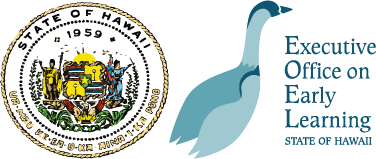FPG Frequently Asked Questions
What are the Family Partnership Guidelines?
The Family Partnership Guidelines (FPG) provides a source document to guide early childhood practitioners in their efforts to create and/or enhance ongoing, responsive and reciprocal relationships with the families enrolled in their programs. The guidelines includes key principles and provides actions or strategies practitioners can use to engage more effectively with families.
Why were they developed?
The Executive Office on Early Learning developed the FPG document as one of the deliverables of its Action Strategy work in an attempt to support practitioners, programs and schools serving children, birth to third grade, to develop authentic and respectful relationships with families The goal is for ongoing partnerships with families to result in improved health and developmental outcomes for Hawaii’s young children. Foundational to the FPG work was the core value that children develop and learn best in the context of a supportive family and that families play a pivotal role in shaping their children’s healthy development and lifelong learning
How were they developed?
The Executive Office on Early Learning (EOEL), in partnership with Hawaii P-20 Partnerships for Education and members of Team 3 of the Action Strategy Initiative (representing the Departments of Education, Health, Human Services and education-based non-profits), reviewed and compared a number of local and national family engagement standards documents. The group identified 6 Key Principles that seemed to be common across the majority of these documents. These Key Principles were also aligned with family partnership standards being recommended in Hawaii’s Board of Education’s proposed Family/School Partnership Policy, which provided an opportunity to promote coordination and alignment of efforts across the p-3 continuum for shared expectations around family partnerships.
For each Key Principle, a rationale was included to describe the significance of that Principle. 3-5 indicators for each Principle were identified that suggested actions/strategies that could be implemented to demonstrate that particular Principle. Indicators included were generic enough to be relevant across programs serving children birth to grade 3, as well as across the diversity of early childhood settings (center-based, home visitation, family child care, and family/child interaction learning programs) and K-3 classrooms.
Once the Principles, Rationale and Indicators were drafted, 15 focus groups, convened on four islands during April and May 2013, reviewed and suggested revisions to the document. Participants included practitioners serving children birth to age 8, as well as family members. Participants provided feedback as to whether the indicator language used was clear, whether the indicators were measurable, and whether they were adaptable to each of the early childhood settings. 191 individuals representing 43 community organizations and/or State entities participated in these focus groups, providing feedback through indicator worksheets, group discussions and a follow-up online survey, if interested. All responses were aggregated anonymously and analyzed to extract the common broad themes, words that were too vague to measure, and questions and/or suggestions to enhance clarity. Based on this feedback, the EOEL revised the Family Partnership Guidelines document. (See accompanying document on “Summary of Changes Made to Family Partnership Guidelines”.)
For whom are these guidelines intended?
These guidelines are intended to be used within early childhood programs/schools serving children, birth to age 8, as a tool to help practitioners engage in meaningful partnerships with families to promote children’s development and learning. While research indicates the pivotal role that families play in their children’s early learning, early childhood practitioners often report that developing meaningful relationships with families is often one of their greatest professional challenges. A recent study of the capacity and effectiveness of higher education institutions in Hawaii in addressing early childhood workforce professional development also affirms the need that more efforts be directed to strengthen practitioners’ confidence and capacity to work effectively with families.
How are they organized?
The document consists of 6 Key Principles, a rationale for each Principle, and 3-5 indicators that suggest actions or strategies that can be implemented to meet the intent of the Principle. These indicators are generic in nature in order to be relevant across early childhood settings serving children birth to age 8. They are not meant to be all-inclusive, but rather, serve as examples to illustrate how a program/school could address the Key Principles.
How are they intended to be used?
The FPG is a tool/source document that provides guidance for how programs/schools can engage families in meaningful and reciprocal partnerships to support their children’s learning. They are not mandatory, nor are they standards that will be evaluated by some entity. Rather, they are meant to support programs/schools in assessing their policies and practices as they engage in continuous quality improvement.
Is implementation mandatory?
No, these guidelines are meant to serve as a resource document and tool for continuous quality improvement.
What kinds of supports might there be for implementation?
Toolkit development is the next step in the Action Strategy plan for implementation. In order to develop the toolkits, more in-depth conversations will need to occur with focus groups representing the different early childhood settings, as well as families, in order to identify examples of existing practices/strategies that support family partnerships. These conversations will also help to identify the kinds of venues of support that might be helpful for practitioners to access. The intent is to develop toolkits that are specific to the different program settings (center-based, home visitation, family child care and family/child interaction learning programs), as well as K-3 classrooms, but that might have relevance to other settings should programs/schools choose to “adopt” certain practices. Possible deliverables for implementation support might include an FPG Handbook, video clips, early childhood programs mentoring other programs in their communities, specific workshops offered as clock-hour training, etc.
Click here for a PDF of the FPG FAQs Summary.
